The Parthenon is the eighth wonder of the world!? Part one (the original text and 35 photos are published for the first time)
On the monument to which I dedicate today's post, of course, everyone has heard. The Parthenon is a symbol of Greece, like the Eiffel Tower in France, the pyramids in Egypt, or the Red Square in Russia. Unfortunately, I saw the Parthenon after visiting the flying monasteries of Meteors and the beautiful ancient city of Delphi. In my presentation, which took shape at the lessons of art history at the university, the Parthenon was to become my most amazing impression of Greece, but this did not happen, since the current state of this structure is very deplorable. But, gradually revealing the secrets of the Parthenon, its meaning became clearer to me. I found evidence that the Parthenon is indeed a great monument of architecture and art worthy of being called a miracle of the world!
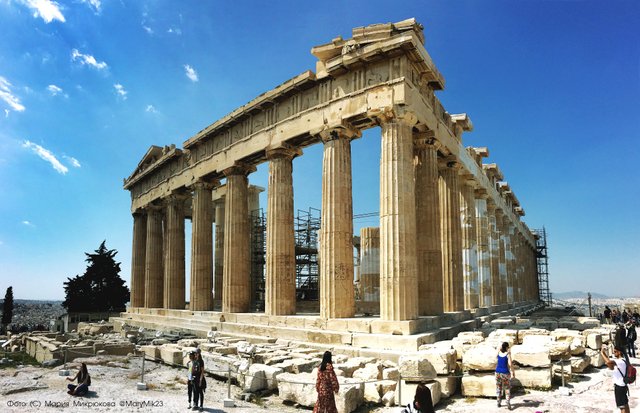
Click on the picture and you can see the picture in a big size
Three councils for tourists planning to visit the Acropolis
And there is this miracle on a rock, whose height above the city is 76 meters, which corresponds to a 25-storey house. "Sacred rock", on which the Acropolis is located, is located in the historical center of Athens, just two minutes walk from the metro station with the same name. It is this vehicle I recommend to use to get to the Parthenon from virtually anywhere in the city. I have already talked about the problems of parking in major cities in Greece, so choose public modes of transport.
Near the Acropolis there are the main monuments of Athens: the Hadrian Library, the Dionysus Theater, the Temple of Zeus, the Temple of Hephaestus, the Odeon, the Areopagus. I understand that for a person who has never been in Greece and not interested in history, all these names make no sense. But if you ever go to Athens, they will help you navigate and do not miss anything, clearly planning an examination of the historic center in one day. By the way, if you used a single tourist ticket to visit all the sights in other European cities, then I would not recommend buying it in Athens, since most antiquities can be viewed from afar, it does not make much sense to go behind the fence.
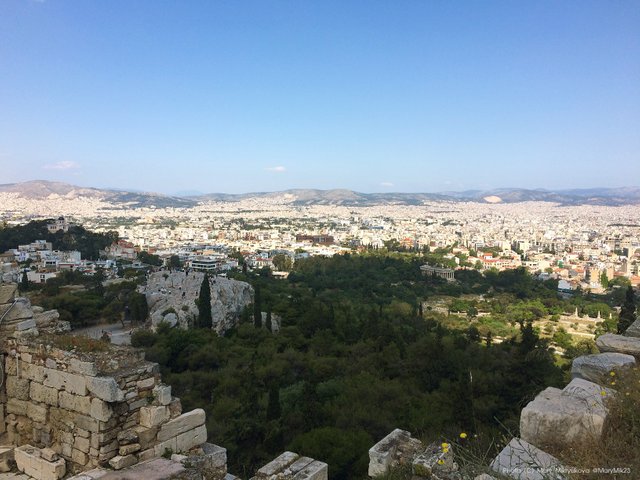
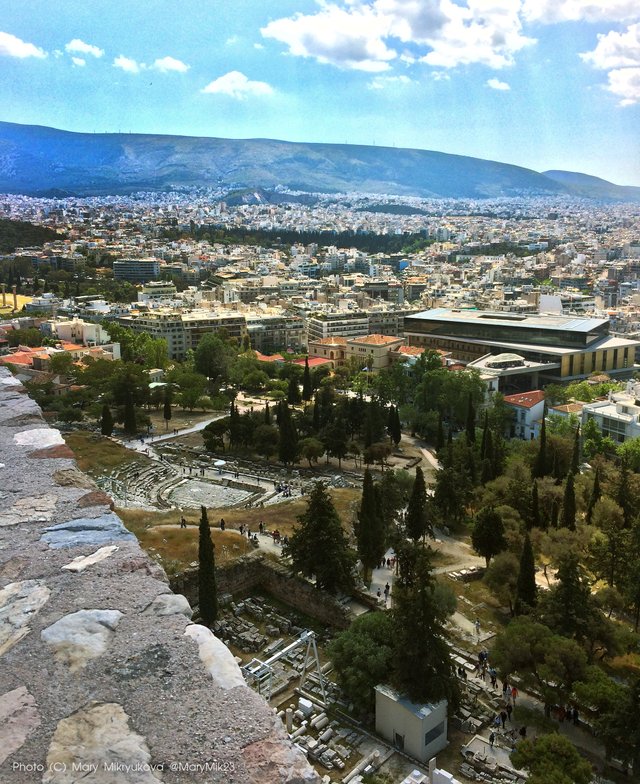
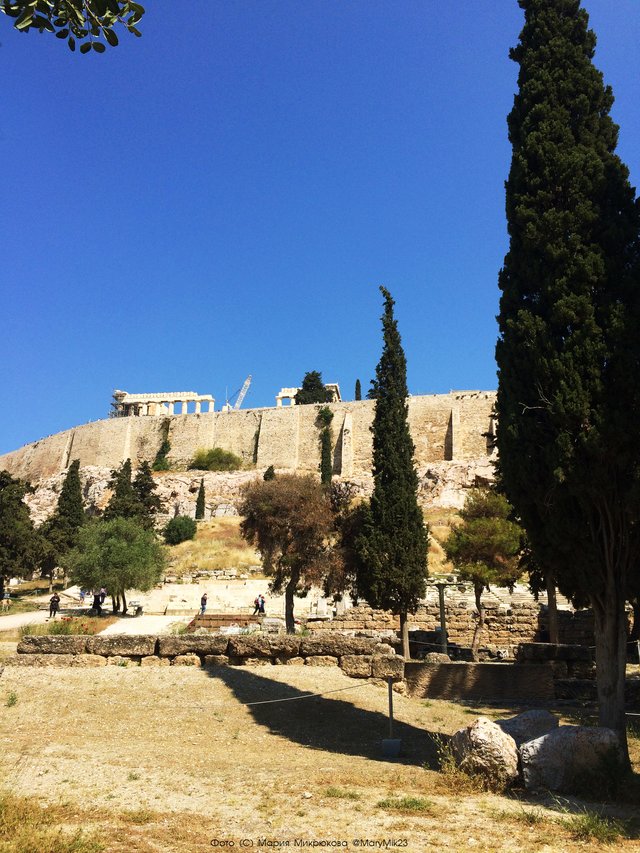
Interesting figures: the age of the Acropolis and the cost of building Parthenon
The place where the Parthenon stands today was sacred many centuries ago. The first religious buildings appeared here in the 15th and 13th centuries BC. The Acropolis was built by the first king of Attica - Cecrops, traditionally born of the supreme goddess Gaia (the goddess of the earth, the mother of all that lives on it), and having two serpentine tails instead of legs. In fact, the Acropolis is a complex of buildings surrounded by a protective wall. The kings who live here, constantly rebuilt their palaces and created new temples. Until now, information about the last temple - Hecatompedon, built in the 6th century BC - has been preserved. During the Greco-Persian war, the temple was burned and looted. It would be logical to use the materials left from it for new buildings, but this was impossible, since marble changes its properties after exposure to high temperatures and becomes unsuitable for construction. Therefore, we can see parts of the columns of this ancient temple inside the wall of the Acropolis. And in the modern museum of the Acropolis there are several sculptures that adorned Hecatompedon, including the famous snake head "Bluebeard." You imagine, the sculpture has not only survived to our days, but also retained its color after dozens of centuries!
The new building of the Acropolis began in 446, or in 447 BC under Pericles. Data on the greatest construction of the era came to us thanks to financial reports that were recorded on marble tablets and provided to citizens who donated money for construction. And the money was spent grandiose. According to one data - 469 talents, and others - 700. It is worth explaining that for one talent it was possible to build a warship, respectively, the Parthenon cost Athens as a large fleet.
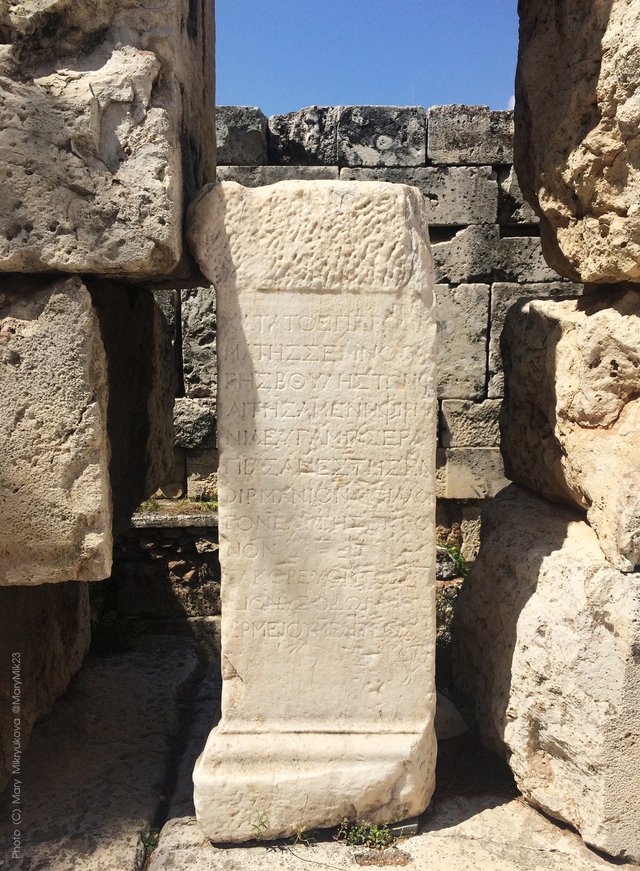
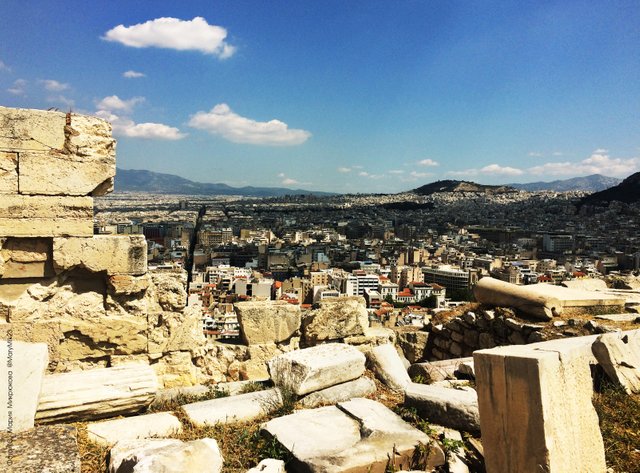
Acropolis, as a symbol of the unification of the country
The main architect and sculptor of the Acropolis was a friend of Pericles Phidias. In addition to his enormous artistic abilities, Phidias had knowledge of geometry and optics, so he could create majestic statues of enormous dimensions that looked proportionate and natural from the height of human growth. It was Phidias who was the author of one of the wonders of the Ancient World - the statue of seated Zeus at Olympia.
Phidias carried out the general management of construction, created statues and reliefs. The Acropolis is a complex of several temples and structures, so other architects worked on its team, including Mysicles, Calliktrates and Ictinus. To get to the Acropolis, it is necessary to bypass the rock on which it is located, and in the western part we see the solemn "gates" of the Propylaea, reminiscent of its outlines temple. I must say that the whole complex of the Acropolis is carefully thought out and its buildings perfectly complement each other. Passing through the Propylaea, we walk along the road, which was driven to the main temple of sacrificial animals. It is for this purpose that the distance between the central columns of the Propylaea is much wider than between the side columns, where there were two marble staircases for people. This strange and symbolic way has to be overcome today by tourists.


The columns of Propylae impress with their size. You understand how heavy their blocks are and how difficult it was to build marble structures. On the columns of the Acropolis is worth paying special attention and for another reason. It was here for the first time that architects used two orders (style) of construction: Doric and Ionic. The aim of Pericles was to unite all of Greece. In ancient times, the west of the country was inhabited by the Dorians, the east by the Ionians. Each group (they used to be called tribes) had their traditions and, in particular, external decoration of temples. Dorians - simple, severe, Ionians - more refined, modern, although their cultures differ little by their appearance. Pericles and Phidias in the basis of the buildings of the Acropolis laid a simple, massive Doric order, but gently complemented it with the elegance and decor of the ionic. Later, I will also tell you about the third Corinthian warrant, which, according to one version of the scientists, appeared here and was represented by only one column. Try to guess where this unusual column could be installed ;)
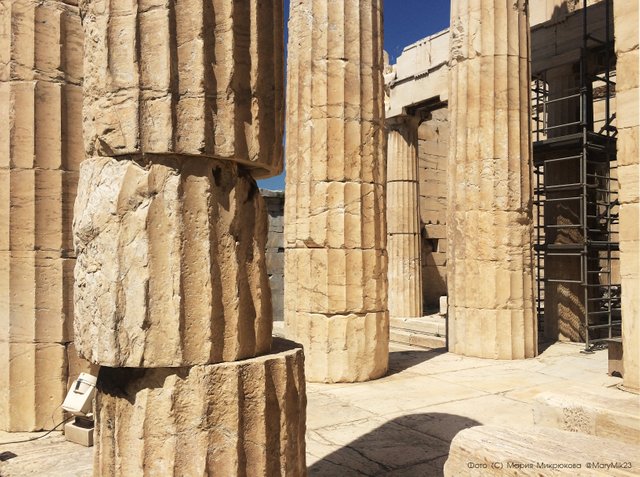
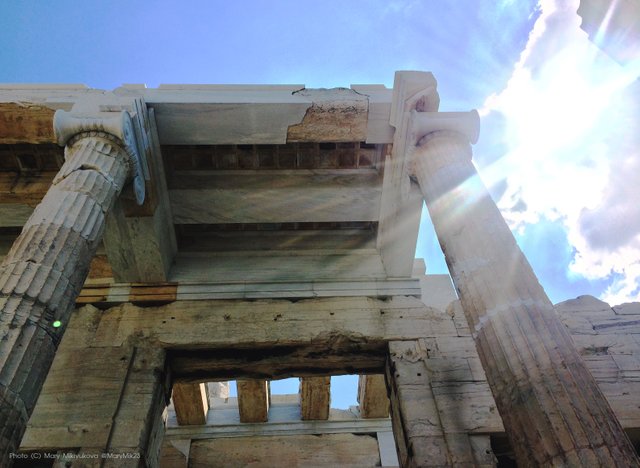
So, we pass through the Propylaea, we see their monumentality and the clarity of space. Doric columns of the entrance group replace the Ionic inner colonnade. In one wing of the Propylae there were the halls of Pinoteka - the storehouses of works of art and painting. In the other - lodges for privileged persons who were lying down to take food, drank wine and admired the temple of Nicky. Propylaea are not symmetrical, because behind the temple of Nicky was the sacred land of Artemis, where construction was impossible.
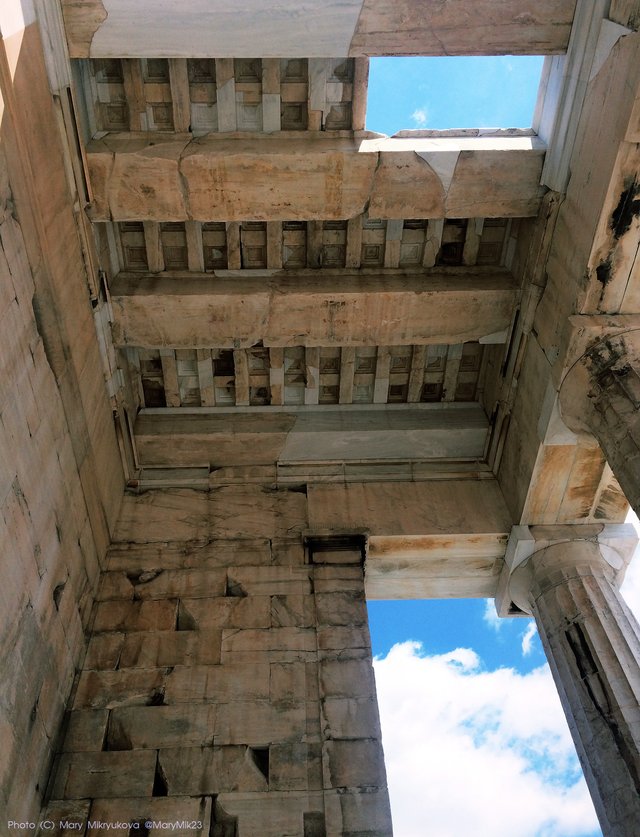
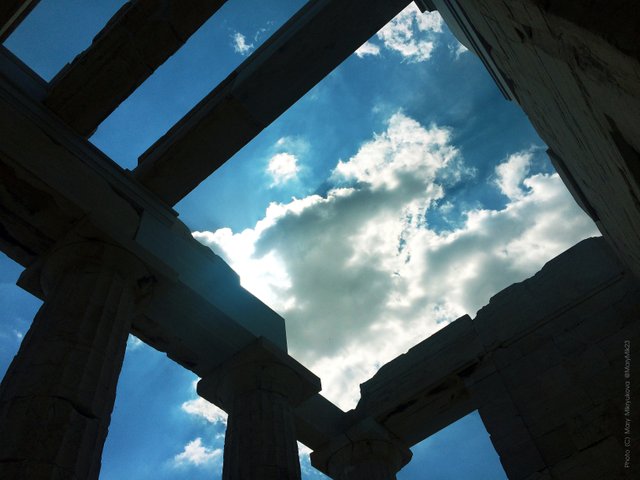
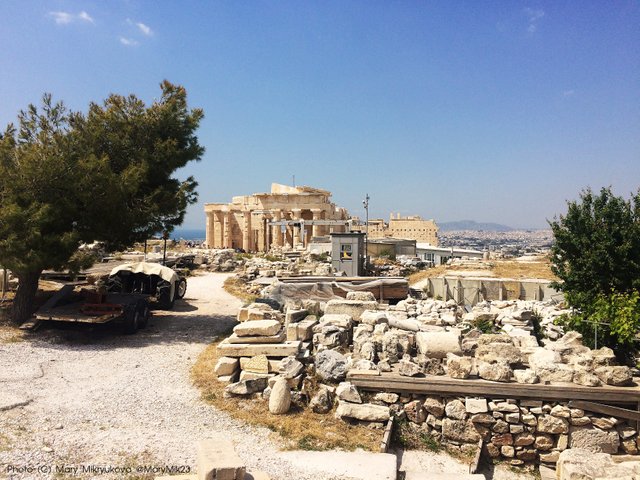
Getting inside the Acropolis, the first thing the ancient Greeks saw was the giant statue of Athena Promachos (fighting in the front row). It was cast from bronze trophies. The height of Athens with a shield and a spear reached 9 meters. This statue was visible from afar, guests arriving in the city on ships, for 65 kilometers could distinguish its outlines. The statue has not survived to this day, but its existence is confirmed by financial documentation and images on ancient Greek coins.
Further, on the left hand the visitor of the Acropolis saw the beautiful Erechtheion - the pearl of the complex. About this temple, I plan to make a separate post, there is much to tell.
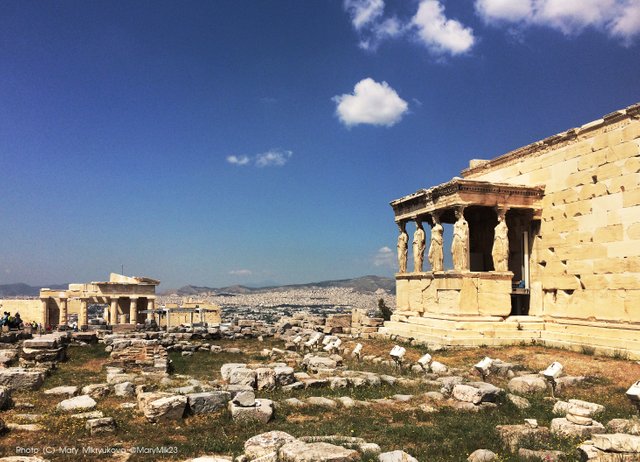
Secrets of the Parthenon: visible and hidden from the eyes
And, finally, the main structure of the Acropolis - Perfenon. This temple is visible from all the main streets of the center of Athens. There is still a rule in the construction of the city does not violate the principle of dominance of buildings on the "Sacred Rock".
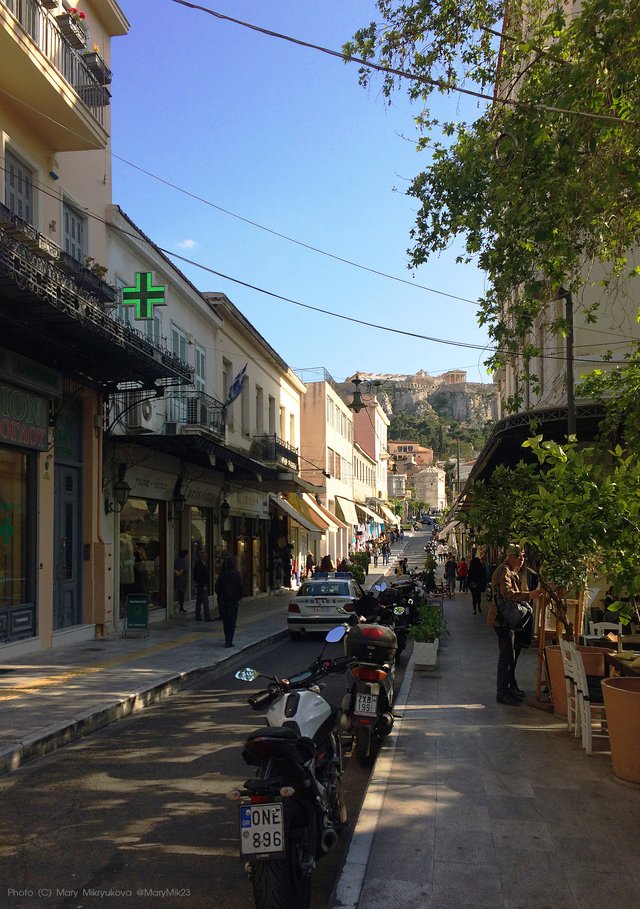
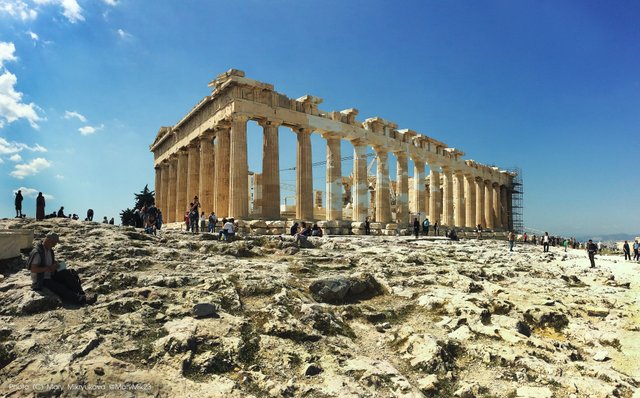
Click on the picture and you can see the picture in a big size
Parthenon - a unique building, the construction of which took into account the peculiarities of the perception of architecture by the human eye. In the Parthenon there is no absolutely straight line. The temple, as it were, embraces the surface of the earth and repeats its outlines. Stylobate - the stepped foundation of the temple in the central part is higher by 11 centimeters, relative to the edges. Its architrave (the horizontal rectilinear part, the beam overlapping the columns) is higher in the center than at the edges, that is, it is literally curved in an arc. The angular columns are somewhat thicker than the others and do not have a circular shape in the section. The columns are slightly tilted into the building, and if they had a height several times higher than now, they would meet at one point at an altitude of about 4800 meters. All these bends were carefully thought out and designed by Fidius to create a temple, ideal for human perception, which watches it from below, in great perspective.

The Parthenon has more columns than any other temple in ancient Greece. There are 8 from the eastern and western sides of the temple and 17 from the north and south. The main entrance to the temple is traditionally from the east side. But people rarely got inside the Parthenon and could see his main treasure only through the open doors of the temple during the holidays.
About this secret treasure and other values of the Parthenon I will tell you in the second part of the post. If you have not subscribed to my blog yet, offer your friendship so that it's easier for us to find each other on Steemit!
Text, photos and good mood - ©Copyright @marymik23 (18.06.2018)
RU
Парфенон - восьмое чудо света!? Часть первая.
О памятнике, которому я посвящаю сегодняшний пост, безусловно, слышали все. Парфенон - это символ Греции, как Эйфелева башня во Франции, пирамиды в Египте, или Красная площадь в России. К сожалению, я увидела Парфенон уже после посещения летающих монастырей Метеоров и прекрасного древнего города Дельфы. В моём представлении, сложившемся на уроках истории искусств в университете, Парфенон должен был стать моим самым потрясающим впечатлением Греции, но этого не произошло, поскольку сегодняшнее состояние этого сооружения весьма плачевно. Но, постепенно открывая тайны Парфенона, его значение становилось более понятным для меня. Я нашла подтверждения того, что Парфенон действительно великий памятник архитектуры и искусства, достойный называться чудом света!
Три совета туристам, планирующим посетить Акрополь
А находится это чудо на скале, высота которой над городом 76 метров, что соответствует 25-этажному дому. "Священная скала", Акрополь расположены в историческом центре Афин, буквально в двух минутах ходьбы от одноименной станции метро. Именно этим средством передвижения я рекомендую воспользоваться, чтобы добраться до Парфенона практически из любой точки города. Я уже рассказывала о проблемах парковки в крупных городах Греции, поэтому выбирайте общественные виды транспорта.
Рядом с Акрополем находятся основные памятники Афин: библиотека Адриана, театр Диониса, храм Зевса, храм Гефеста, Одеон, Ареопаг. Я понимаю, что для человека, которые никогда не был в Греции и не интересовался историей, все эти названия не имеют никакого смысла. Но если вы когда-нибудь отправитесь в Афины, они помогут сориентироваться и ничего не пропустить, четко спланировав осмотр исторического центра в течение одного дня. Кстати, если вы использовали в других городах Европы единый билет туриста для посещения всех достопримечательностей, то в Афинах покупать его я бы не советовала, поскольку большинство древностей можно осмотреть издалека, заходить за ограждение не имеет большого смысла.
Интересный цифры: возраст Акрополя и стоимость строительства Перфенона
Место, где сегодня стоит Парфенон, было священным еще много веков назад. Первые культовые сооружения появились здесь еще в 15-13 веках до нашей эры. Акрополь построил первый царь Аттики - Кекропс, по преданию рожденный верховной богиней Геей, и имеющий два змеиных хвоста вместо ног. По сути, Акрополь - это комплекс зданий, окруженных защитной стеной. Цари, непосредственно проживающие здесь, постоянно перестраивали свои дворцы и создавали новые храмы. До наших дней сохранились сведения о последнем храме - Гекатомпедоне, построенном в шестом веке до нашей эры. Во время греко-персидской войны храм был сожжен и разграблен. Логично было бы использовать материалы, оставшиеся от его для новых построек, но это было невозможно, поскольку мрамор меняет свои свойства после воздействия высоких температур и становится непригодным для строительства. Поэтому части колонн этого древнейшего храма мы можем увидеть сегодня замурованными в стене Акрополя. А в современном музее Акрополя представлено несколько скульптур, украшавших Гекатомпедон, в том числе знаменитая змеиная голова "Синяя борода". Вы представляете, скульптура не только дожила до наших дней, но и сохранила свой цвет спустя десятки веков!
Новая застройка Акрополя началась в 446, либо в 447 году до нашей эры при Перикле. Данные о величайшем строительстве эпохи дошли до нас благодаря финансовым отчетам, которые записывались на мраморных табличках и предоставлялись горожанам, жертвующим деньги на строительство. А средства были затрачены грандиозные. По одним данным - 469 талантов, а по другим - 700. Стоит пояснить, что за один талант можно было построить военный корабль, соответственно, Парфенон стоил Афинам как большой флот.
Акрополь, как символ объединения страны
Главным архитектором и скульптором Акрополя был друг Перикла Фидий. Помимо колоссальных художественных способностей Фидий владел знаниями геометрии и оптики, благодаря чему он мог создавать величественные статуи огромных размеров, которые с высоты человеческого роста выглядели пропорционально и естественно. Именно Фидий был автором одного из чудес Древнего Мира - статуи сидящего Зевса в Олимпии.
Фидий осуществлял общее руководство строительством, создавал статуи и рельефы. Акрополь - это комплекс нескольких храмов и сооружений, поэтому в его команде работали и другие архитекторы, в том числе Мнесикл, Калликрат и Иктин.
Чтобы попасть в Акрополь, необходимо обойти скалу, на которой он расположен, и в западной части мы видим торжественные "ворота" Пропилеи, напоминающие своими очертаниями храм. Нужно сказать, что весь комплекс Акрополя тщательно продуман и его здания прекрасно дополняют друг друга. Проходя через Пропилеи, мы идём по дороге, которой гнали к главному храму жертвенных животных. Именно для этого расстояние между центральными колоннами Пропилеи гораздо шире, чем между боковыми, где находились две мраморные лестницы для людей. Вот такой странный и символичный путь сегодня приходится преодолевать туристам.
Колонны Пропилей впечатляют своими размерами. Ты понимаешь насколько тяжелы их блоки и какого труда стоило строительство сооружений из мрамора. На колонны Акрополя стоит обратить особое внимание и по другой причине. Именно здесь впервые архитекторы использовали сразу два ордера (порядка, стиля) строительства: дорический и ионический. Целью Перикла было объединение всей Греции. В древности запад населяли дорийцы, восток - ионийцы. У каждой группы (их раньше называли племенами) были свои традиции и, в том числе, внешнего оформления храмов. Дорийцы - простые, суровые, ионийцы - более утонченные, современные, хотя их культуры по времени возникновения разнились незначительно. Перикл и Фидий в основу зданий Акрополя положили простой, массивный дорический ордер, но мягко дополнили его изяществом и декором ионического. Позднее я расскажу еще и о третьем коринфском ордере, который по одной из версий ученых появился именно здесь и был представлен всего лишь одной колонной. Попробуйте угадать, где могла быть установлена эта необычная колонна ;)
Итак, мы проходим через Пропилеи, видим их монументальность и четкость пространства. Дорические колонны входной группы сменяет ионическая внутренняя колоннада. В одном крыле Пропилей находились залы Пинотеки - хранилища произведений искусства, живописи. В другом - ложи для привилегированных персон, которые лёжа принимали пищу, пили вино и любовались храмом Ники. Пропилеи не симметричны, поскольку за храмом Ники была священная земля Артемиды, где строительство было невозможно.
Попадая в Акрополь, первое что видели древние греки - гигантская статуя Афины Промахос (сражающаяся в первом ряду). Она была отлита из бронзовых трофеев. Высота Афины с щитом и копьем достигала 9 метров. Эта статуя была видна издалека, гости, прибывающие в город на кораблях, за 65 километров могли различить её очертания. Статуя не сохранилась до наших дней, но её существование подтверждает финансовая документация и изображения на древнегреческих монетах.
Далее, по левую руку посетитель Акрополя видел прекрасный Эрехтейон - жемчужину комплекса. Об этом храме я планирую сделать отдельный пост, есть о чем рассказать.
Секреты Парфенона: видимое и скрытое от глаз
И, наконец, главное сооружение Акрополя - Перфенон. Этот храм виден со всех крупных улиц центра Афин. Здесь до сих пор действует правило при застройке города не нарушать принципа доминирования построек на "Священной скале".
Парфенон - уникальное здание, при строительстве которого были учтены особенности восприятия архитектуры человеческим глазом. В Парфеноне нет ни одной абсолютно прямой линии. Храм как бы обнимает поверхность земли и повторяет её очертания. Стилобат - ступенчатое основание храма в центральной части выше на 11 сантиметров, относительно краёв. Его архитрав (горизонтальная прямолинейная часть, балка, перекрывающая колонны) в центре выше, чем по краям, то есть, он буквально изогнут дугой. Угловые колонны несколько толще остальных и в разрезе не имеют форму круга. Все колонны немного наклонены внутрь здания, и если мысленно продолжить их вверх, то они встретятся в одной точке на высоте около 4800 метров. Все эти изгибы были тщательно продуманы и спроектированы Фидием, чтобы создать храм, идеальный для восприятия человеческом, который наблюдает его снизу, в большом ракурсе.
У Парфенона больше колонн, чем у любого другого храма Древней Греции. Их 8 с восточной и западной сторон храма и по 17 с северной и южной. Главный вход в храм по традиции с восточной стороны. Но люди крайне редко попадали внутрь Парфенона и могли видеть его главное сокровище только через раскрытые двери храма во время праздников.
Круто и фото супер 👍👍👍
Вы уже здесь! 👍 Спасибо, приятно, что фото понравились. Завтра вторую часть размещу...
This post has just received lots of ♡♡♡#LOVE♡♡♡ and a 54.13% upvote from @haveaheart!
Thank you for your thoughtfulness in choosing this service.
@haveaheart donates 10% of all received profit to the Sri Sathya Sai Heart Hospital
Click here to make a difference
Delegate to haveaheart and support a charity that really cares.
Daily payouts for delegators are 85%.
(Be sure to leave at least enough SP undelegated that your account is still usable.)
Thank you @haveaheart! You have a very good goal to direct funds to charity. I wish you well!
Congratulations! This excellent post was chosen by the new curation initiative of the @postpromoter content promotion service to receive a free upvote!
This post exemplifies the type of great content that we at @postpromoter enjoy reading and would love to see more of on the Steem platform. Keep up the good work!
Thank you @postcurator, @postpromoter! I will definitely continue to write good posts and I hope for your support!
Great work. :)
Hello! I am very glad to see you among the commentators of my report on Greece. Tomorrow I will publish the second part about the sculpture and reliefs of the Parthenon. Did you find errors in the names in my text? I'm always afraid of this...
Pericles wasn't king. He was a leading political figure.
It's Calliktrates and Ictinus.
Thank you, correct! It's very difficult to translate.
This post was shared in the Curation Collective Discord community for curators, and upvoted and resteemed by the @c-squared community account after manual review.
Thank you @c-squared!
Heya, just swinging by to let you know you're being featured in our Daily Travel Digest!
Thank you @steemitworldmap! Recently I was written by a girl who saw my mark on your map and set off on the motives of my travels! I am very glad that the message was useful for travelers!
What lens did you use to take the first photo?
All my photos are made using the Iphone 5S. I am often asked which camera I use, but this is just an ordinary phone of the old model.
This post was amazing and your photos are great! Might I suggest checking out this cool little website. https://www.jpegmini.com/ It will help your steemit articles load much faster :) I've also chosen this post to be today's lucky winner of a @postpromoter upvote courtesy of @yabapmatt and the @postcurator initiative. Congratulations!
Thank you @crystalhuman and thank you @postpromoter for your support. This support is very necessary to continue to write quality articles for Steemit.
Можно зачет по истории архитектуры сдавать :)
А я сдавала, только экзамен... по истории искусств, пять лет сдавала. Но изучать историю искусств на месте этой самой истории гораздо интереснее, чем по учебникам в университете.
"Перикл и Фидий в основу зданий Акрополя положили простой, массивный дорический ордер" :-)
Знаешь, ставить Перикла и Фидия на одну ступень - это смелое заявление в исторической науке) Наверное, вряд ли крупнейший политик занимался подбором ордера для зданий Акрополя.
Хотя тот же Лужков записан в авторы Христа Спасителя, и да, зачем далеко ходить... наш БК записан автором памятника Долгорукому))))
Перикл безусловно был идеологом строительства. Вообще очень много нюансов в этой истории и сегодня можно предположить всё что угодно. Одна "подпись" Перикла и Фидия на щите главной статуи Афины чего стоит.
Кстати, я лично наблюдала, как современные "цари" одним росчерком пера правили творения гениальных архитекторов. Не мне тебе об этом рассказывать ;)
Нифига себе! Прямо подпись можно посмотреть? Так вот у кого БК идею украл.
"Подпись" в виде портретов ) за что Фидий был наказан. Но это не помешало ему получить новый заказ на статую Зевса...
Я сдаюсь)
Εξαιρετική δουλειά!!!
Thank you very much for your comment! Are you from Greece?
Yes, I am from Corinth (Corinthians in the Bible)
I was in the Peloponnese and admired the Corinthian canal. This post describes my whole journey through Greece
Greattttt post!!! Judging from you, Russians are fond of Greece too huh? :)))
I can not be responsible for everyone... I visited many countries of the world and Greece impressed me very much. Especially I liked the monasteries of Meteora, Delphi, Chalkidiki and Parthenon of course )
I think historically and religion wise Russia (as many Eastern European countries) see Greece as their spiritual fathers through the Byzantine Empire. I could be wrong, but that's my impression
I often heard this version, it is possible that it is really so. Even our president visited Athos...
You have recieved a free upvote from minnowpond, Send 0.1 -> 2 SBD with your post url as the memo to recieve an upvote from up to 100 accounts!